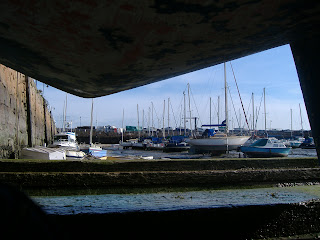 As you can see from the photo opposite, there is quite an accumulation on the bottom of my boat. Not surprising as the boat hasn't been treated for at least 3 years. I'd scraped the many barnacles off the bits I could reach a few months ago, but the weed had returned. There were still plenty of barnacles between the keels I just couldn't get to.
As you can see from the photo opposite, there is quite an accumulation on the bottom of my boat. Not surprising as the boat hasn't been treated for at least 3 years. I'd scraped the many barnacles off the bits I could reach a few months ago, but the weed had returned. There were still plenty of barnacles between the keels I just couldn't get to.So, half-term seemed the ideal time to start on Project Anti-foul. Tides were good, HT mid morning, and the weather was looking great.
Saturday and Sunday low tide afternoons were spent scrubbing, sanding and scraping, with my small band of 'helpers' in the form of my three eldest children, aged 4-7, who actually spent much more time flinging black harbour mud at each other.
On Sunday I decided to have a go between the keels, so attached a rope to the mast halyard and pulled hard from behind canting the boat back on it heels, while my children slid a plank under the keels. Worked quite well but still couldn't get to all the barnacles and the boat was sitting in its own little puddle so lying down under it wasn't an option.
I was trying to avoid using the drying pad that I'd book for the day on Monday, as a) I didn't think there would be enough water on it at HT and b) because I was really anxious about moving the boat around in a crowded harbour with an engine that doesn't want to run at slow speeds and a boat I'm not used to handling.
 Monday was a great day! I rowed over the drying pad at 10:15am with the dinghy and 'sounded'. Didn't look that deep and HT was only 20 mins away. Also tried the same at the blocks further round where there appeared to be a bit more. (Showing 0.8m on the scale next to the blocks).
Monday was a great day! I rowed over the drying pad at 10:15am with the dinghy and 'sounded'. Didn't look that deep and HT was only 20 mins away. Also tried the same at the blocks further round where there appeared to be a bit more. (Showing 0.8m on the scale next to the blocks). If anybody ever wonders whether you can tow a Seawych with a dinghy and oars, I can say 'yes' but I wouldn't recommend it! I'd rigged up the rudder and tried the engine just in case I got into trouble (how much trouble can you get into going THAT slow!). The Seawych slewed all over the place behind the dinghy but I eventually gained control.
I floated her over the blocks and appeared to have about 1ocm clearance on a falling tide. I quickly jumped up the ladder, tied the boat up, every movement on the boat gently bumping the blocks. Tying a rope to either end I pulled it into position. Sadly the blocks are too far apart and the keels don't sit quite right, but what I saw when the water had gone was better than I imagined.
I spent the next couple of hours tending to those regions that never otherwise get accessed. Finally removed all the barnacles, sanded and scrubbed between the keels and the inside surfaces. The freshwater was provided by a stream running down through the harbour at low tide, which needed a tramp through deep harbour-bottom mud for each and every bucketfull.

A pleasant break in the almost-warm sunshine while it dried, and then the painting began. I have to confess at this point that the overriding philosophy this year is to get the boat operational as quickly as possible with as little effort and cost as possible. So, the 'prepared' finish was still pretty rough, but sound. Even so the painted surfaces look pretty good from a distance of about 10 yards.
I still have the bow and stern sections to do. Watch this space. I'm now stuck on the blocks until Sunday at 5pm, due to tides.

No comments:
Post a Comment